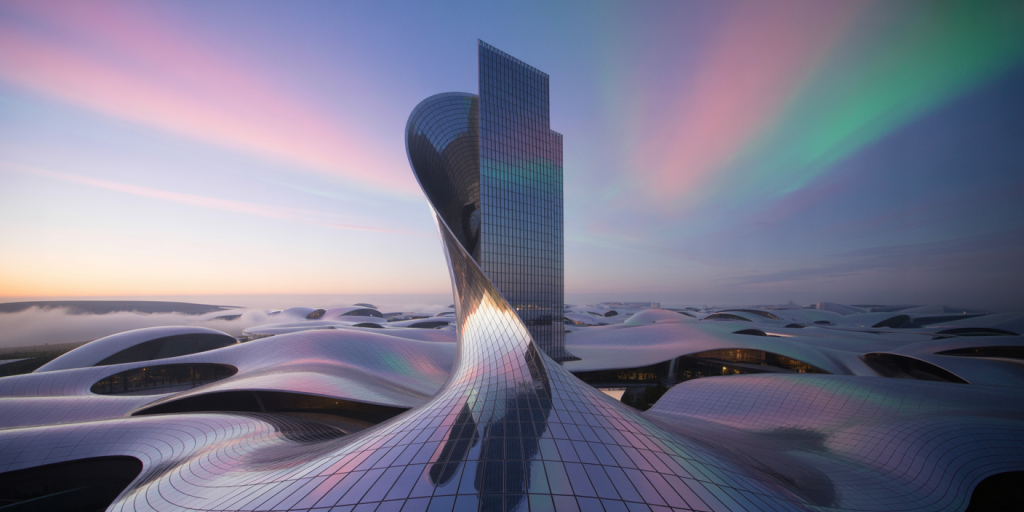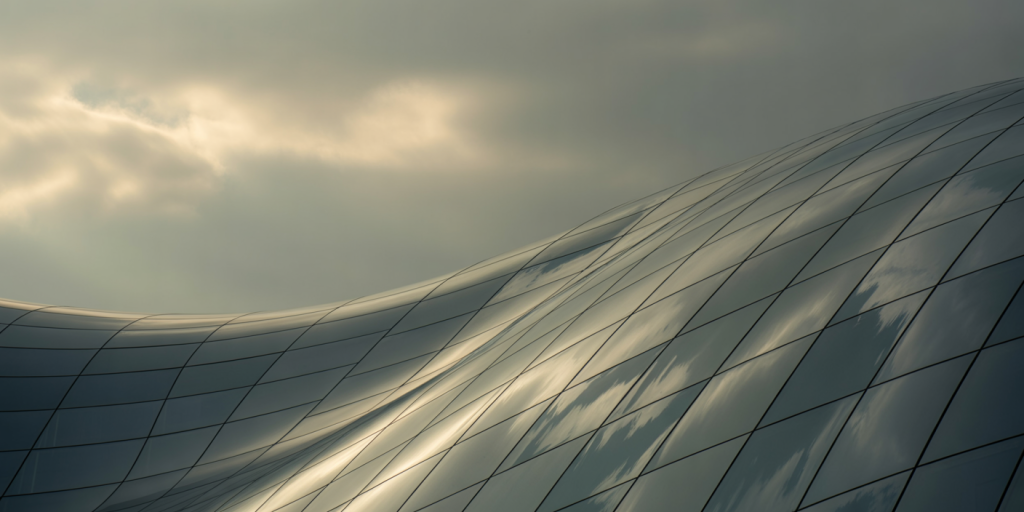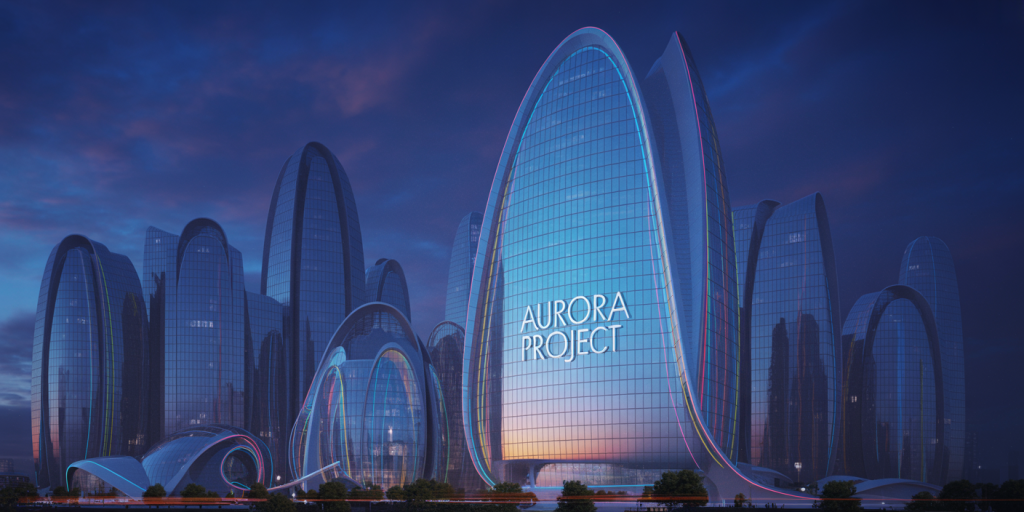Glass Horizons: Fragments of Soul in the Cities of Zaha Hadid
There are buildings that dominate, and there are buildings that dance. Zaha Hadid did not design cities — she sculpted motion in the static, wrote dreams in glass, and cast the wind in steel. Her urban visions are not containers of life but extensions of breath, curving like rivers, flowering like galaxies, expanding like thought.
Standing before her cities is not to confront geometry, but to experience music — a rhythm of lines that refuse to obey, curves that defy gravity, and shadows that slip like silk across translucent skin. In Hadid’s world, architecture becomes emotion with edges, soul molded into skylines. Her structures are fragments of the future suspended in the present.

Poetic Table of Contents
- Cities That Refuse to Stand-Still
- The Architecture of Liquid Steel
- Curves That Breathe
- Where Glass Becomes Emotion
- The Poetic Weight of Asymmetry
- Reflections from the Future
- Shadows in Motion
- Spaces That Whisper and Sing
- Between Silence and Velocity
- Texture of Transparency
- The Feminine Shape of Innovation
- Echoes of Cosmos in Urban Form
- Emotional Gravity in Concrete
- Drawing with Time, Not Lines
- The Pulse Inside the Structure
- Cities that Remember Light
- Sculpting the Unseen
- Buildings That Do Not-End
- Geometry Dissolved in Feeling
- Skylines as Soft Thunder
Cities That Refuse to Stand Still
Hadid’s cities are never frozen. They twist, lean, tilt — not toward collapse, but toward transformation. A building is not just a form, but a verb. It stretches forward, escapes itself, like a dancer leaning into flight.
These cities suggest movement even when still. They hold kinetic potential — not aggression, but a smooth urgency, as if drawn by invisible tides. Her architecture refuses stability as virtue. Instead, it celebrates becoming.
The Architecture of Liquid Steel
Steel, under Hadid’s vision, ceases to be rigid. It flows. Columns bend, beams arch, ceilings unfurl like petals or smoke. What was once fixed becomes alive — a paradox sculpted in alloy.
This fluidity is not chaos, but orchestration. Her control over this movement is total, but never authoritarian. The materials surrender not by force, but by seduction.
Curves That Breathe
The curve is her language — not the cold, perfect arc of compass geometry, but the organic undulation of breath. Curves wrap around the sky, unfold across streets, melt into reflection.
In these curves lies empathy. They comfort, welcome, soften the alienation of cities. Her architecture embraces rather than confronts. It breathes alongside us.
Where Glass Becomes Emotion
Hadid paints with glass. Not as a transparent window, but as an emotional veil. It catches light like skin catches memory — reflecting, diffusing, glowing.
Glass is no longer a passive surface. It becomes a character. It responds to sun and shadow, to color and cloud. Her buildings shimmer with change — an evolving mood, an embodied emotion.
The Poetic Weight of Asymmetry
In Zaha’s hands, imbalance becomes harmony. Her compositions tilt, widen, spiral — breaking symmetry not in rebellion, but in liberation. She finds grace in irregularity.
This asymmetry speaks to our lives — always leaning, always adjusting, never perfect, yet always beautiful. She invites us to abandon precision and trust in fluidity.
Reflections from the Future
Her buildings feel sent from tomorrow. They are alien not in hostility, but in wonder. They show us what we could be if we let imagination build cities.
These reflections offer hope — not nostalgia, but anticipation. The future is not brutalist or cold; it is lyrical, radiant, and deeply human.
Shadows in Motion
Light and shadow move differently across Hadid’s works. The forms invite dance. There are no flat casts — only flowing darkness, creeping curves of dusk, shadows that meander.
The buildings become stages for time itself. Light plays here, rests there, vanishes and reappears — like memory across the surfaces of the mind.
Spaces That Whisper and Sing
Inside, her spaces do not echo. They whisper. Walls do not close; they breathe. Ceilings don’t press; they float. Sound moves softly — a hum rather than a hammer.
These interiors are sanctuaries for thought, for pause, for becoming. They are less architecture and more invitation — into reverie, into silence, into ourselves.
Between Silence and Velocity
Her cities exist in contradiction — silent, yet urgent; still, yet rushing forward. This paradox gives life to her structures. They seem to wait, but for what?
They hold the tension between meditative silence and the energy of speed. That in-between becomes fertile — the space where art happens.
Texture of Transparency
Not all textures are touchable. Some are emotional. The way her surfaces feel — without hand — is part of her genius. Smooth glass becomes soft. Sharp corners vanish.
There’s a sensuality in the lack of texture, a provocation in the absence. What’s not there becomes as tactile as what is — the invisible rendered real.
The Feminine Shape of Innovation
Her forms are unapologetically feminine. Not decorative, but powerful. They curve without needing permission. They swell, wrap, undulate, stretch.
In this lies resistance — against the boxy masculine of corporate modernism. She offers fertility, not rigidity; softness as strength. She redesigns power through form.
Echoes of Cosmos in Urban Form
There are galaxies in her buildings — spirals, craters, celestial alignments. She draws the language of astronomy into steel and glass. Cities become constellations.
Walking among her structures is like floating in organized infinity. You are small, but not insignificant. Her architecture makes space for awe.

Emotional Gravity in Concrete
Even her concrete holds emotion. It doesn’t crush — it lifts. It doesn’t contain — it flows. The heavy becomes graceful. The mass moves with you.
Her concrete is not blunt. It is carved with care, curved with intent, built with poetic weight. She gives it grace, turning mass into message.
Drawing with Time, Not Lines
Hadid did not draw with rulers. She drew with time — its swirls, its flows, its gentle chaos. Her sketches seem improvised but are meticulous, musical, alive.
Her architecture follows this rhythm. A building doesn’t start and stop. It evolves. It’s not constructed — it emerges, like weather or melody.
The Pulse Inside the Structure
You can feel a heartbeat inside her buildings. The curves throb with invisible motion. The glass blinks. The staircases breathe.
There’s an aliveness that transcends function. Even an airport, under her hand, feels more like a womb than a corridor. You are not passing through — you are being held.
Cities that Remember Light
Her architecture memorizes light. At noon, it glows; at dusk, it hushes. Each moment changes the building, and the building receives it.
Her cities are never static. They evolve with the sun, reflect the mood of the sky. They respond. They remember. And in doing so, they feel alive.
Sculpting the Unseen
Zaha gave form to forces we don’t see: gravity, time, motion, feeling. She did not build objects — she built expressions. Her architecture is sculpture for the unseen.
This is not just design. It is emotion encoded in space. You do not walk through her buildings. You are moved by them.
Buildings That Do Not End
There are no hard edges. No definite starts. Her structures loop, slide, recede. They resist boundaries. They extend beyond themselves, mentally and visually.
Even when finished, they seem incomplete — like thoughts left open for continuation. They are not monuments. They are possibilities.
Geometry Dissolved in Feeling
She dissolves geometry in favor of experience. There are shapes, yes, but they are softened, loosened, blurred by intention. The result is affective, not analytical.
You do not measure her work. You feel it. You do not trace its angles. You follow its breath. Geometry serves emotion — and in that, finds transcendence.
Skylines as Soft Thunder
Her skyline presence is not a shout. It’s a murmur of thunder — soft but impossible to ignore. Her buildings do not demand your gaze. They absorb it.
They stand not in domination, but in grace. Their power lies in mystery, in the beauty of form that needs no explanation. They thunder quietly — and echo forever.

FAQ – Questions and Answers
Who was Zaha Hadid?
Zaha Hadid was an Iraqi-British architect and the first woman to win the Pritzker Prize. Known for her radical, fluid, futuristic forms, she redefined contemporary architecture with visionary, emotionally resonant buildings.
What is unique about her architectural style?
Her style is marked by fluid curves, dynamic asymmetry, and organic forms that dissolve traditional geometry. Her work blends structural innovation with emotional and visual poetry.
Why are curves so important in her work?
Curves represent freedom, movement, and natural flow. For Hadid, curves were a rebellion against the boxy rigidity of conventional architecture — a celebration of life in form.
How does she use glass in her buildings?
Glass becomes expressive under her hand — not just a window but a reflective, emotional skin. It captures the mood of the moment and becomes part of the building’s evolving presence.
Are her buildings practical or purely artistic?
Both. While her forms are bold and visionary, her buildings are rigorously engineered. She balanced poetry with precision, ensuring that function never constrained feeling.
Final Reflections – Cities That Speak in Curves
Zaha Hadid did not design buildings. She orchestrated sensations. Her structures do not simply stand — they ripple, exhale, hum. They reject the static and embrace the evolving. They do not hold life — they become it.
In her cities, glass becomes soul, steel becomes breath, space becomes feeling. She redefined what architecture could mean — not shelter, but story. Not containment, but expression. In the mirrored surfaces of her dreams, we do not just see the city — we see ourselves, rewritten in light and curve.
